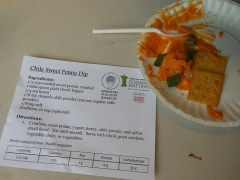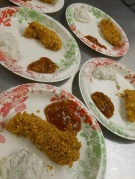The VA has a program called Health Promotion Disease Prevention (HPDP) and we dietetic interns each spent three weeks with the program.
HPDP is very different than the clinical rotations. With clinical rotations, the focus is fixing the immediate health problem the patient is facing. With HPDP, the focus is to prevent the health problem in the first place. This is a concept I think a lot of health professionals can get behind. Heck, not just health professionals – everyone! It’s no secret that health promotion and disease prevention will save money and lives in the long run.
But I digress! With HPDP, I got to participate in a variety of wellness projects, not just nutrition projects. I wrote newsletter articles on safe driving that will be used in the winter newsletters. I helped out with a Cooking Matters class that was just for Veterans and had a lot of fun working with the Veterans in the class. A lot of them had never cooked before being in the class, so it was nice to coach them along so that they did all the real cooking work. During the class, one Veteran asked me if I thought that foods with chemicals in them were bad and he went on to tell me about an email he had gotten that told him lard and butter were better for him than the “so-called heart healthy stuff” or supplements. Apparently the email told him that anything with a chemical sounding ingredient was automatically bad for his health. I pointed out that it all packaging can be misleading unless you’re really paying attention to the label, pointing out that one food might have a lot of sugar in it but the sugar could be listed in three different forms so it doesn’t get listed as the first ingredient. He pressed the issue, so I finally asked him if he’d drink a glass of dihydrogen monoxide. His immediate answer was “Of course not!” He was kind of taken aback when I told him it was another name for water. The RD I was working with was amused by that conversation. (If you ever want to chuckle, check out http://www.dhmo.org/ – I find it quite hilarious.)
I also observed and led nutrition portions of MOVE! classes. MOVE! is a great weight loss program run by the VA. I’ve helped out with MOVE! classes now in two different VA systems and it’s always amazing to help out with the classes. The in-person weight loss classes are taught by a three-person team – a dietitian, a physical therapist, and a psychologist. The dietitian goes over the nutrition topic for the day, the physical therapist teaches exercises and ways to modify the exercises so everyone can do them, and the psychologist goes over behavior change strategies to help make the weight loss a lasting change. MOVE! is truly a lifestyle change class and it’s amazing to see the progress of the Veterans who participate.
While I had fun with everything I’ve mentioned so far, my favorite part of HPDP ended up being something I wasn’t originally scheduled to do. On my last day, I went with one of the HPDP dietitians to Camp Hope, a non-profit lodge specifically for the use of combat Veterans, to help teach a cooking class. The Veterans were there for a multi-day retreat just for Veterans who had suffered TBI and they were working with social workers, physical therapists, psychologists, and a whole host of other health professionals. We were there to help them learn healthy cooking habits by having them make their own lunch for the day. I think a lot of the Veterans were a little nervous when the RD told them, “This is your lunch, so you guys better follow the recipes because you guys are going to have to eat it. There is no backup meal.” They all ended up doing great and a few of them who claimed they never cooked seemed proud of themselves for cooking, and deservedly so. We were also there to encourage them to break out of the “meat and potatoes” mindset and a few were surprised to learn that vegan chocolate cake tastes just as good as regular chocolate cake. Camp Hope is a truly wonderful place and I highly encourage anyone who can volunteer or help out with it to do so.
HPDP definitely ranks up there as one of the highlights of the internship. The Veterans I worked with were all great, as was everyone who was an HPDP employee. I can easily envision myself working in a health promotion field now.





